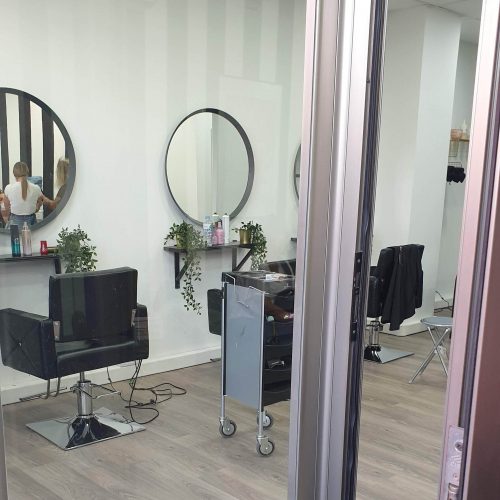
7 Steps to a Successful Peluquería Trip (Getting a Haircut in Spain)
 Dear Marion,
Dear Marion,
We all know that getting a haircut can be a stressful experience, now imagine adding to it the need to communicate in a different language. You can only hope that the hairdresser doesn’t misunderstand you and haphazardly chop off all your beautiful locks. It’s enough to keep you at home with those split-ends until the end of your semester in Spain. But fear not! You can confidently and successfully visit the peluquería (hair salon) for whatever hair-care service you need. Here you can find our pro tips for a smooth, well-groomed experience while living abroad:
Before your appointment
1.) Know what you want: Have a clear idea of what you want so you can anticipate (and potentially look up) any vocabulary you might need to explain yourself to your hairdresser. We recommend taking some time to think about this before you venture into a hair salon (even if you are just going in to schedule an appointment, as you will likely be asked what the appointment is for).
 Of course, depending on where you find yourself, there’s a good chance someone may be able to communicate with you in English. However, we recommend utilizing Spanish if you can. Here are some key words that may be of use to you:
Of course, depending on where you find yourself, there’s a good chance someone may be able to communicate with you in English. However, we recommend utilizing Spanish if you can. Here are some key words that may be of use to you:
-
Corte: haircut
-
Lavado: wash
-
Peinado: style
-
Planchado: straightened
-
Rizado: curled
-
Tinte: dye
-
Mechas: highlights
-
Reflejo: lightening (less noticeable, thinner version of ‘mechas‘ that really seem to shine or ‘reflect’ in the sunlight)
-
Capas: layers
-
Flequillo: bangs
 2.) Find a photo: Where your words may fail you, a picture should not! Even after years of living in Spain and feeling quite confident explaining what we want, we still make sure to bring a number of photos to the peluquería to reiterate particular points. Of course, this is less essential if you are merely looking for a trim, but very useful if you are going for a new look. This will also help your hairdresser get an idea of the exact colors, lengths of layers, etc. that you want (which can be difficult to verbalize in any language, unless you are a seasoned stylist yourself).
2.) Find a photo: Where your words may fail you, a picture should not! Even after years of living in Spain and feeling quite confident explaining what we want, we still make sure to bring a number of photos to the peluquería to reiterate particular points. Of course, this is less essential if you are merely looking for a trim, but very useful if you are going for a new look. This will also help your hairdresser get an idea of the exact colors, lengths of layers, etc. that you want (which can be difficult to verbalize in any language, unless you are a seasoned stylist yourself).
3.) Shop around: Check out pricing at a few different places before you commit to one. If you have Spanish friends or know others who have lived in the area for a while, ask for their hair salon recommendation. Alternatively, you can check out reviews online but keep in mind that some of the most long-standing, high quality salons with regular local patrons may not have many reviews, but this does not mean they are not great.
Also, price does not always equate to quality in Spain. You could find an incredible hairdresser who charges very little or a horrendous one with a central location that therefore charges a fortune. Get an idea of the going rates in your area and don’t pay more than the average unless you have reason to believe that it will, indeed, be worth it.
Pro-tip: Don’t be afraid to ask if there are any discounts available! It’s common to find lower rates for students or jovenes (youths, which is usually up to 26).
 4.) Make an appointment: This is not necessary in many salons, but it can be a good tactic to help you feel the most comfortable. This way, you have two opportunities to explain what you want (and clarify if you think you were misunderstood the first time). Also, if you have a tendency to get talked into more treatments or higher prices than you really want to pay you, this can be especially helpful. It gives you a chance to think through it all before the appointment and craft your explanation for not getting all of the services on the day of your appointment—and/or cancel the appointment altogether over the phone.
4.) Make an appointment: This is not necessary in many salons, but it can be a good tactic to help you feel the most comfortable. This way, you have two opportunities to explain what you want (and clarify if you think you were misunderstood the first time). Also, if you have a tendency to get talked into more treatments or higher prices than you really want to pay you, this can be especially helpful. It gives you a chance to think through it all before the appointment and craft your explanation for not getting all of the services on the day of your appointment—and/or cancel the appointment altogether over the phone.
Pro-tip: Be sure to ask for a business card or snap a photo of their phone number (often posted outside) in case you need to get in contact. Of course, in today’s day and age you’re likely to be able to find the salon on Google Maps to get the number later, but if it’s a newer establishment or you’re in a small town, this method occasionally doesn’t work.
At your appointment
5.) Talk with your hands: Especially if you have been speaking Spanish for a while, it’s understandable if you usually try to use only your words and not rely on gestures to communicate. Oftentimes, this can make us feel like we stand out even more as a language-learner. However, if there were ever a time to fall back on visual cues, it’s now!
Think about how you act when you get your haircut in your native language—chances are you still point and demonstrate what you are saying in order to be clear. Getting your hair cut or styled is simply a visual experience so don’t hesitate to include additional clues that will help your hairdresser achieve what you’re looking for.
 6.) Speak up: As with any service experience, you are the customer and you are meant to receive the service that you actually asked for. Don’t be afraid to speak up if you see that what you want is not happening (or, ideally, if you even have an inkling that it’s not going to be the result you desire). It can help to ask follow-up questions to be sure that your requests were understood. For example, inquiring if the dye (s)he is about to apply to your hair is for las mechas (the highlights), not a tinte entera (full dye), may help you avoid leaving the salon platinum-blonde when all you wanted was a little lightening.
6.) Speak up: As with any service experience, you are the customer and you are meant to receive the service that you actually asked for. Don’t be afraid to speak up if you see that what you want is not happening (or, ideally, if you even have an inkling that it’s not going to be the result you desire). It can help to ask follow-up questions to be sure that your requests were understood. For example, inquiring if the dye (s)he is about to apply to your hair is for las mechas (the highlights), not a tinte entera (full dye), may help you avoid leaving the salon platinum-blonde when all you wanted was a little lightening.
7.) Be appreciative, but not too generous: When it comes time to pay, remember that Spain is not a tip-based culture. If you are truly unhappy with the treatment you received, you do not need to give a tip at all. Even if you are ecstatic about your new look, you don’t need to tip to say thanks! Although we know this, we can admit that the guiri in us still feels the need to leave something.
True story: The first time Dani went to the peluquería in Spain she was uncertain about the tipping culture so she decided to err on the side of generosity and give a 20% tip like she would back home. Thankfully, the hairdresser told her ‘absolutely no’ and resisted her tip until she lowered it to 5€. It was lucky for Dani that the hairdresser didn’t want to take advantage of her generosity, but not everyone will have the same experience.
In general, we find that simply dropping a euro or two into the tip jar will put a smile on their faces. Still, Spanish friends have assured us that this is not at all expected, so do as you feel best and know that it is not rude to pay the bill exactly. Also, if you at all feel like you are being taken advantage of with the pricing (i.e. the cost they quoted you when you made the appointment was much lower than what they ask you to pay at the end), say something and absolutely don’t feel guilty about not leaving a tip.
 Don’t worry, be happy
Don’t worry, be happy
If you keep these tips in mind, we believe you’ll be on the road to a successful peluquería trip. Still, like haircut/style/coloring experiences anywhere, you may leave the salon a bit decepcionad@, or underwhelmed. For some reason, hairdressers around the world seem to have a knack for doing the exact opposite of what you asked for.
Sometimes, that’s just the way it goes and it really has nothing to do with your language skills and/or how well you could explain yourself. Personally, however, after a week with a new hairstyle we always end up loving it, so be open-minded and try not to get too upset in the moment. As with anything, no pasa nada! At least hair eventually grows back, haha!
Have you gone to the hair salon in Spain? What was your experience like?
Sincerely,
Spain




